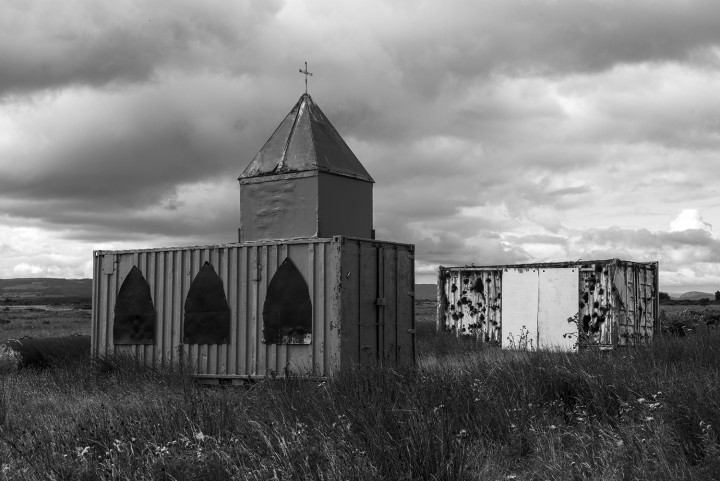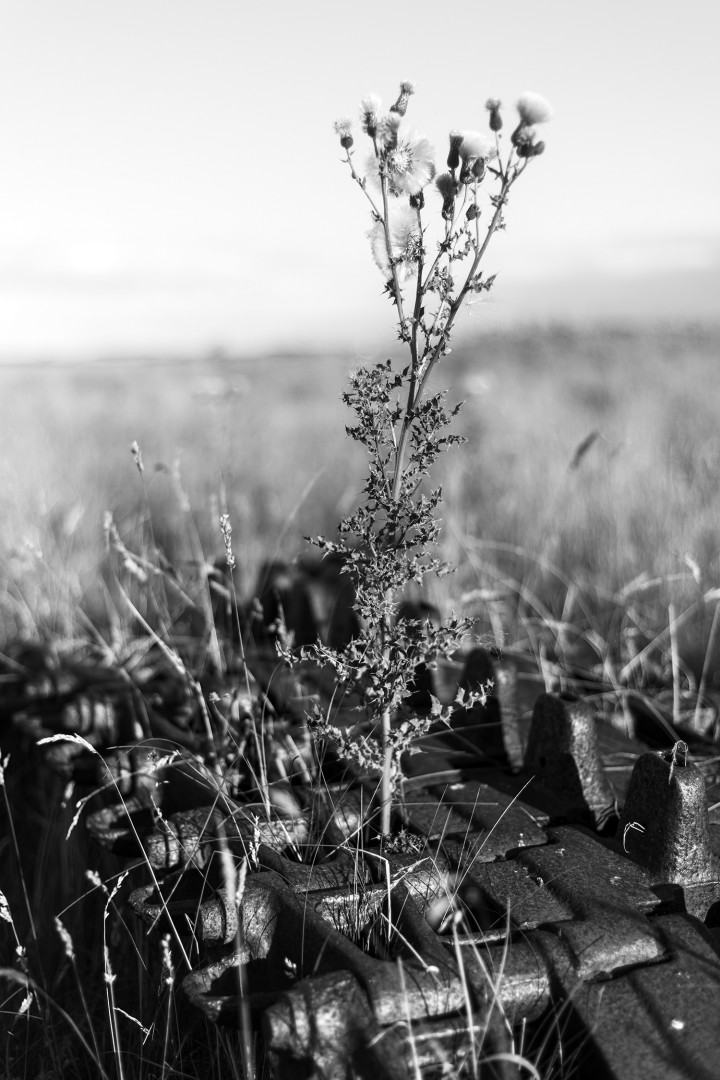Scottish Art News
Latest news
Magazine
News & Press
Publications
Outdoor Shoots
By Greg Thomas, 19.10.2021

Of all the memorable images in Alex Boyd’s Tir an Airm (“Land of the Military”), the ones that most stuck in my mind on the train home were of hastily assembled dummy buildings and vehicles used as target practice: a church made from an old corrugated metal container on Tain Air Weapons Range; a boxy chipboard car unwittingly reminiscent of a Lada or other iron-curtain hulk; a lonely fragment of fake wall set against a wide, flat horizon; a tank fashioned from a disassembled skip.
What is arresting about these ersatz monuments to human life extends beyond the obvious fact of their use by people planning to extinguish lives. It’s also the seemingly unnecessary architectural and artistic flourishes. Why does a model church on an air weapons range need an approximation of gothic arches? Why not flying buttresses too? Why does the vehicle need a number plate (SG64 WWS, out of interest)? What’s the point of adding lines of illusory brickwork to a model bridge presumably built to be blown up?
 Alex Boyd, Dummy village - the church, 2020. 2020. © Alex Boyd (2020). Courtesy Stills.
Alex Boyd, Dummy village - the church, 2020. 2020. © Alex Boyd (2020). Courtesy Stills.
One possible explanation is that these details serve as focal points for the cross-hairs of the circling bomber, encamped gunner, or remote drone pilot, incorporated into the design as a macabre twist on form-follows-function modernism. But the unconscious effect is to give an at-once unnecessarily vivid and weirdly naïve impression of the realpolitik of the situation. It’s as if it were glimpsed, but only dimly, what would ultimately be at stake in the accuracy of the trigger finger and the eye’s adjustment: the limbs and minds of real people inside real churches and cars. Or maybe that effect is deliberate too. Now that a village in Iraq can be obliterated by a drone pilot sitting down in Lincolnshire, is it perceived at some level that military recruits should have at least a half-formed sense of what it is they are actually doing?
Probably not. In any case, the effect is also – as the artist notes in conversation after the show – something like a bullet-strafed Trumpton. And this is where the (pitch-black) humour of Boyd’s work comes into play. Like the stone-carved toy aircraft carrier and warplanes at Ian Hamilton Finlay’s Little Sparta, the interplay of violence and childlike naivety in these images might dislodge a guilty giggle. Then again, the toytown cuteness has broader and less amusing implications for the terms of our engagement – as tourists, critics, connoisseurs – with a national wilderness exalted continuously in print and paint. We don’t come to the Scottish highlands or rolling lowlands to encounter these scenes, and we aren’t generally allowed to clap eyes on their most obvious markers, yet it seems we are sometimes looking right at them, or through them.
As the gallery’s exhibition notes make clear, many of the hundred miles of land that German-Scottish photographer Boyd traversed for this show are “hidden behind red flags.” But some of us might have occasionally skirted past a checkpoint, a “tanks crossing” sign, a derelict brutalist pillbox. Image 11, Thistle and Tank Track, RAF Tain, gets closest to bringing the subtext to the surface: the militarisation of the Scottish landscape has always been a secret held in plain sight, an absent presence within popular conceptions of the place. Perhaps what we hold in our minds is the wilderness equivalent of a toytown, a bowdlerised image and sense of what is really there.
 Alex Boyd, Thistle grows in destroyed tank track, 2020. © Alex Boyd (2020). Courtesy Stills.
Alex Boyd, Thistle grows in destroyed tank track, 2020. © Alex Boyd (2020). Courtesy Stills.
On that note, it is clear that a power of collaborative research underpins the development of this show, and it would have been enlightening – though perhaps uncomfortable for the MoD, whose magazine Sanctuary (“the Ministry of Defence Sustainability Magazine”) is dotted around the foyer – to know more about the history and presence of these sites. Throughout Tir an Airm, however, Boyd finds ways of obliging us to engage with reality. Some works, such as a frieze-like arrangement of photographs depicting bombed landscapes “with shell craters, vehicles and deer” in Cape Wrath and Tain, utilise the dazzlingly detailed aerial perspectives of drone footage. As with Richard Mosse’s majestic shots of ravaged Amazon jungle, these pieces adapt and subvert the surveillance and reconnaissance techniques of the forces being interrogated: whether that’s the armed forces or the newly empowered mining and logging lobby in Bolsonaro’s Brazil.
Boyd has also given over a section of the show to the artist Mhairi Killin, whose cleaned-up section of military drone, downed in training off the coast of North Uist, again presses home the actuality of the situation. Oddly, however, when presented with this literal physical evidence, the mind wanders and starts to find sculptural analogies for the tangled metalwork; is this some kind of art brut? Jean Dubuffet on the Hebrides? Hurry to Stills before 13 November to find out, and to explore a gripping reengagement with the Scottish military pastoral.




